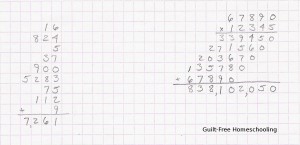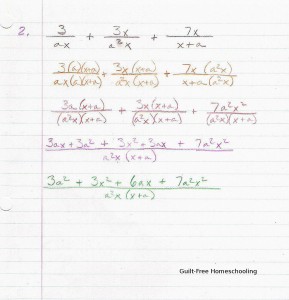Do your student’s math papers sometimes look more like a tangled jumble of numbers instead of neatly arranged problems? Do you have a student who gets confused over complex math problems? Our old friends, graph paper and color, can come to the rescue once again!
Graph paper was a blessing when my young students began writing math problems, but their numbers sometimes wandered aimlessly down the page, causing us to wonder which place value some digits represented. Using 1/4″ graph paper (4 squares per inch), I showed my son how to put one digit in each square and line up all of the ones’ column digits. That way, the tens’ digits ended up in the correct column, as did every other place value. It helped my student keep track of his math problems, which helped him perform the calculations correctly, which led to faster learning. It was a great benefit for the small price of a pad of graph paper.
Math function signs can be written in colors for kids who struggle with noticing which operation is required or in which order certain operations should be done. For example, parentheses in their favorite blue may catch their eyes first, and they know to do that before going on to the yellow plus signs later.
For particularly large and difficult math problems with complex fractions or higher math, I encouraged my kids to use an entire sheet of paper for each problem, if necessary. I told them they could make only as many changes per step as they were comfortable with and instructed them to leave a blank line after each step of the problem. That made it much easier for them to tell where they were and what they were doing. It also helped them to know they could use as much paper as necessary to be able to understand the steps and the transformations of tricky calculations (paper is cheap; understanding is priceless). Spread those numbers out so you can see exactly which digit belongs where, and skip a line between steps for amazing clarity in those super complicated problems.
Something my daughter Jen came up with on her own was to write each step with a different colored pencil. She is a strong visual learner, so color often played an important role in her schoolwork, and her set of colored pencils seemed like a natural tool to use for understanding the transitions in how each step changed from the one before it. The colors helped her eyes and brain differentiate one step from another, so the changes were much easier to see and understand. Using colored pencils can also work for students who get overwhelmed by trying to solve large math problems, helping them to focus on only one step at a time.
For those students who have difficulty understanding what is happening in each step, color can also be used to show the process of solving. The parent-teacher can write out everything in black pencil that remains the same for the next step, and use color only for the changing elements, to clarify what was changed in each step and exactly how it changed. Use a different color for each step to keep the transitions easier to follow.
Color can also make math more interesting for students who find math to be boring but find art to be all kinds of fun. Perhaps doing math in color is just the enticement little Billy or Sally needs! Bonus tip: Erasable colored pencils are well worth the slightly higher price!





 Guilt-Free Homeschooling is the creation of Carolyn Morrison and her daughter, Jennifer Leonhard. After serious disappointments with public school, Carolyn spent the next 11 years homeschooling her two children, from elementary to high school graduation and college admission. Refusing to force new homeschooling families to re-invent the wheel, Carolyn and Jennifer now share their encouragement, support, tips, and tricks, filling their blog with "all the answers we were looking for as a new-to-homeschooling family" and making this website a valuable resource for parents, not just a daily journal. Guilt-Free Homeschooling -- Equipping Parents for Homeschooling Success!
Guilt-Free Homeschooling is the creation of Carolyn Morrison and her daughter, Jennifer Leonhard. After serious disappointments with public school, Carolyn spent the next 11 years homeschooling her two children, from elementary to high school graduation and college admission. Refusing to force new homeschooling families to re-invent the wheel, Carolyn and Jennifer now share their encouragement, support, tips, and tricks, filling their blog with "all the answers we were looking for as a new-to-homeschooling family" and making this website a valuable resource for parents, not just a daily journal. Guilt-Free Homeschooling -- Equipping Parents for Homeschooling Success!

Speak Your Mind